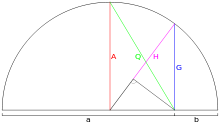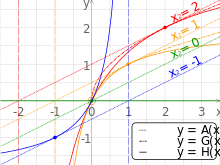A geometric construction of the Quadratic mean and the Pythagorean means (of two numbers a and b ). Harmonic mean denoted by H , Geometric by G , Arithmetic by A and Quadratic mean (also known as Root mean square ) denoted by Q . Comparison of the arithmetic, geometric and harmonic means of a pair of numbers. The vertical dashed lines are asymptotes for the harmonic means. In mathematics, the three classical Pythagorean means are the arithmetic mean (A ), the geometric mean (G ), and the harmonic mean (H ). They are defined by:
A
(
x
1
,
…
,
x
n
)
=
1
n
(
x
1
+
⋯
+
x
n
)
{\displaystyle A(x_{1},\ldots ,x_{n})={\frac {1}{n}}(x_{1}+\cdots +x_{n})}
G
(
x
1
,
…
,
x
n
)
=
x
1
⋯
x
n
n
{\displaystyle G(x_{1},\ldots ,x_{n})={\sqrt[{n}]{x_{1}\cdots x_{n}}}}
H
(
x
1
,
…
,
x
n
)
=
n
1
x
1
+
⋯
+
1
x
n
{\displaystyle H(x_{1},\ldots ,x_{n})={\frac {n}{{\frac {1}{x_{1}}}+\cdots +{\frac {1}{x_{n}}}}}}
Each mean has the following properties:
Value preservation:
M
(
x
,
x
,
…
,
x
)
=
x
{\displaystyle M(x,x,\ldots ,x)=x}
First order homogeneity :
M
(
b
x
1
,
…
,
b
x
n
)
=
b
M
(
x
1
,
…
,
x
n
)
{\displaystyle M(bx_{1},\ldots ,bx_{n})=bM(x_{1},\ldots ,x_{n})}
Invariance under exchange:
M
(
…
,
x
i
,
…
,
x
j
,
…
)
=
M
(
…
,
x
j
,
…
,
x
i
,
…
)
{\displaystyle M(\ldots ,x_{i},\ldots ,x_{j},\ldots )=M(\ldots ,x_{j},\ldots ,x_{i},\ldots )}
i
{\displaystyle i}
j
{\displaystyle j}
Averaging:
min
(
x
1
,
…
,
x
n
)
≤
M
(
x
1
,
…
,
x
n
)
≤
max
(
x
1
,
…
,
x
n
)
{\displaystyle \min(x_{1},\ldots ,x_{n})\leq M(x_{1},\ldots ,x_{n})\leq \max(x_{1},\ldots ,x_{n})}
These means were studied with proportions by Pythagoreans and later generations of Greek mathematicians (Thomas Heath, History of Ancient Greek Mathematics) because of their importance in geometry and music.
There is an ordering to these means (if all of the
x
i
{\displaystyle x_{i}}
quadratic mean
Q
=
x
1
2
+
x
2
2
+
⋯
+
x
n
2
n
{\displaystyle Q={\sqrt {\frac {x_{1}^{2}+x_{2}^{2}+\cdots +x_{n}^{2}}{n}}}}
min
≤
H
≤
G
≤
A
≤
Q
≤
max
{\displaystyle \min \leq H\leq G\leq A\leq Q\leq \max }
with equality holding if and only if the
x
i
{\displaystyle x_{i}}
inequality of arithmetic and geometric means and a special case of an inequality for generalized means . This inequality sequence can be proved for the
n
=
2
{\displaystyle n=2}
a and b using a sequence of right triangles (x , y , z ) with hypotenuse z and the Pythagorean theorem , which states that
x
2
+
y
2
=
z
2
{\displaystyle x^{2}+y^{2}=z^{2}}
z
>
x
{\displaystyle z>x}
z
>
y
{\displaystyle z>y}
[ 1]
(
b
−
a
b
+
a
a
b
,
2
a
b
a
+
b
,
a
b
)
=
(
b
−
a
b
+
a
a
b
,
H
(
a
,
b
)
,
G
(
a
,
b
)
)
,
{\displaystyle \left({\frac {b-a}{b+a}}{\sqrt {ab}},{\frac {2ab}{a+b}},{\sqrt {ab}}\right)=\left({\frac {b-a}{b+a}}{\sqrt {ab}},H(a,b),G(a,b)\right),}
showing that
H
(
a
,
b
)
<
G
(
a
,
b
)
{\displaystyle H(a,b)<G(a,b)}
(
b
−
a
2
,
a
b
,
a
+
b
2
)
=
(
b
−
a
2
,
G
(
a
,
b
)
,
A
(
a
,
b
)
)
,
{\displaystyle \left({\frac {b-a}{2}},{\sqrt {ab}},{\frac {a+b}{2}}\right)=\left({\frac {b-a}{2}},G(a,b),A(a,b)\right),}
showing that
G
(
a
,
b
)
<
A
(
a
,
b
)
{\displaystyle G(a,b)<A(a,b)}
and
(
b
−
a
2
,
a
+
b
2
,
a
2
+
b
2
2
)
=
(
b
−
a
2
,
A
(
a
,
b
)
,
Q
(
a
,
b
)
)
,
{\displaystyle \left({\frac {b-a}{2}},{\frac {a+b}{2}},{\sqrt {\frac {a^{2}+b^{2}}{2}}}\,\right)=\left({\frac {b-a}{2}},A(a,b),Q(a,b)\right),}
showing that
A
(
a
,
b
)
<
Q
(
a
,
b
)
{\displaystyle A(a,b)<Q(a,b)}



![{\displaystyle G(x_{1},\ldots ,x_{n})={\sqrt[{n}]{x_{1}\cdots x_{n}}}}](https://wikimedia.org/api/rest_v1/media/math/render/svg/4b515904d8f34a3cf79416819601eb459ea6470d)



















